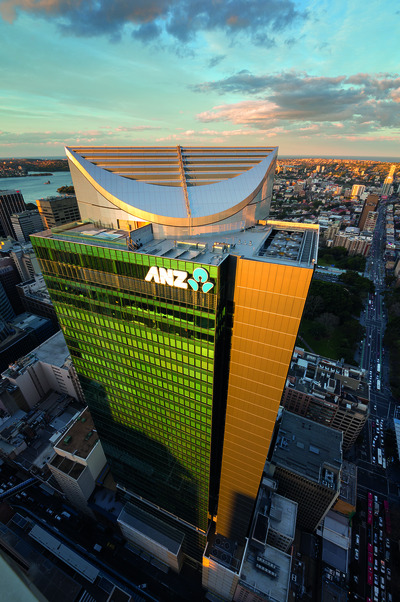ANZ Tower installs lighting controls for energy savings
Monday, 02 December, 2013
Developed by Grocon and designed by leading architects Francis-Jones Morehan Thorp, ANZ Tower is the newest addition to the Sydney skyline. The building officially opened in September 2013 and has already been awarded the 6 Star Green Star - Office Design v2 rating by the Green Building Council of Australia.
ANZ Tower is home to NZ Bank, global law firm Herbert Smith Freehills and Boston Consulting Group. The building has a net lettable area of 59,000 m2 over 44 levels and features high-efficiency chillers, a trigeneration plant, a thermally shielded automated facade and rainwater harvesting. The design of the building’s iconic roof structure and highly glazed facade allows high levels of daylight into the floor-plate.
mySmartCTI was awarded the four major components of the lighting control system comprising the Base Building and the tenancy fit-outs of ANZ, Herbert Smith Freehills and Boston Consulting Group. One of the key sustainability initiatives in the building is the KNX lighting control system from systems integrator mySmartCTI. At over 1800 devices, this is said to be the largest KNX project in the Southern Hemisphere.
The two main requirements of the lighting design were the need for flexibility in configuring the open-plan office spaces, including any future reconfiguration, and the need to maximise the efficiency of the lighting solution to reduce energy consumption. The lighting control solution uses KNX control with the lighting ballasts on DALI networks. KNX/DALI Gateways from ABB ensures streamlined connectivity. An ABB KNX touch screen located close to the lift core on each level and Hager KNX wall switches strategically located throughout the floor allow the users to manually operate the lighting in specific areas when required.

A highlight of the project has been the interfacing of the tenants’ AV requirements into the KNX lighting control solution. To achieve this, over 30 AMX KNX interfaces have been used throughout the building’s meeting spaces, allowing the setting of lighting scenes and controlling the curtains and blinds within these rooms.
An ethernet backbone runs through the building linking the NETx Automation Voyager-based lighting control server to the various KNX networks. Finally, the KNX lighting control solution is interfaced to the building management system via a KNX/BACnet interface. This allows scheduling of the lighting in areas throughout the building including offices, car parks and the external lighting and signage from the BMS.
To ensure the building’s lighting system uses the minimum amount of energy, daylight harvesting and presence/absence detection strategies have been employed. KNX detectors throughout the building constantly monitor the ambient daylight levels across the floor and automatically adjust the lighting to suit.
Combined with the presence detectors, this ensures that the optimum light level is delivered while reducing energy wastage. Specific attention has been paid to after-hours lighting. Naturally the safety and security of any occupants working late is paramount and this is ensured while also using a minimum level of energy to do so. This is achieved through the highly flexible lighting control solution and numerous user interface points. mySmartCTI chose KNX for ANZ Tower over a proprietary solution due to the several benefits of the protocol. These include: KNX is a global standard; KNX products from all manufacturers are certified to be compatible; all KNX manufacturers must be ISO9001 compliant; the protocol is independent from any hardware or software technology; there are over 300 KNX manufacturers/members globally.
For building owners, managers and tenants, these key benefits of KNX are said to lead to better performance and reduced maintenance costs over the life span of the building. This is because as updated or improved KNX products or solutions become available they can be easily incorporated knowing that they are fully certified and compatible with the existing KNX solution. An additional reason for the use of a KNX solution on the ANZ Tower project was that the tenant clients both had specific requests regarding the finish and functionality of the sensors and user interfaces that were simply not achievable with proprietary systems.
Foiling hackers in the smart home era
Australian researchers have devised a camera that obscures images beyond human recognition, thus...
Smart mobility in Helsinki
Helsinki is beating the world in smart mobility, according to the Urban Mobility Readiness Index...
Why indoor air quality is an urgent matter
While the pandemic highlighted the need to better protect people from airborne viruses and...







